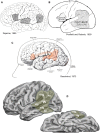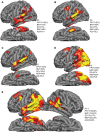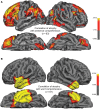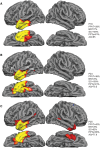The Wernicke conundrum and the anatomy of language comprehension in primary progressive aphasia
- PMID: 26112340
- PMCID: PMC4805066
- DOI: 10.1093/brain/awv154
The Wernicke conundrum and the anatomy of language comprehension in primary progressive aphasia
Abstract
Wernicke's aphasia is characterized by severe word and sentence comprehension impairments. The location of the underlying lesion site, known as Wernicke's area, remains controversial. Questions related to this controversy were addressed in 72 patients with primary progressive aphasia who collectively displayed a wide spectrum of cortical atrophy sites and language impairment patterns. Clinico-anatomical correlations were explored at the individual and group levels. These analyses showed that neuronal loss in temporoparietal areas, traditionally included within Wernicke's area, leave single word comprehension intact and cause inconsistent impairments of sentence comprehension. The most severe sentence comprehension impairments were associated with a heterogeneous set of cortical atrophy sites variably encompassing temporoparietal components of Wernicke's area, Broca's area, and dorsal premotor cortex. Severe comprehension impairments for single words, on the other hand, were invariably associated with peak atrophy sites in the left temporal pole and adjacent anterior temporal cortex, a pattern of atrophy that left sentence comprehension intact. These results show that the neural substrates of word and sentence comprehension are dissociable and that a circumscribed cortical area equally critical for word and sentence comprehension is unlikely to exist anywhere in the cerebral cortex. Reports of combined word and sentence comprehension impairments in Wernicke's aphasia come almost exclusively from patients with cerebrovascular accidents where brain damage extends into subcortical white matter. The syndrome of Wernicke's aphasia is thus likely to reflect damage not only to the cerebral cortex but also to underlying axonal pathways, leading to strategic cortico-cortical disconnections within the language network. The results of this investigation further reinforce the conclusion that the left anterior temporal lobe, a region ignored by classic aphasiology, needs to be inserted into the language network with a critical role in the multisynaptic hierarchy underlying word comprehension and object naming.
Keywords: aphasia; dementia; grammar; language; semantics.
© The Author (2015). Published by Oxford University Press on behalf of the Guarantors of Brain. All rights reserved. For Permissions, please email: journals.permissions@oup.com.
Figures






Similar articles
-
The Wernicke conundrum revisited: evidence from connectome-based lesion-symptom mapping.Brain. 2022 Nov 21;145(11):3916-3930. doi: 10.1093/brain/awac219. Brain. 2022. PMID: 35727949 Free PMC article.
-
The anterior temporal lobes support residual comprehension in Wernicke's aphasia.Brain. 2014 Mar;137(Pt 3):931-43. doi: 10.1093/brain/awt373. Epub 2014 Feb 10. Brain. 2014. PMID: 24519979 Free PMC article.
-
Aphasia.2024 Oct 29. In: StatPearls [Internet]. Treasure Island (FL): StatPearls Publishing; 2025 Jan–. 2024 Oct 29. In: StatPearls [Internet]. Treasure Island (FL): StatPearls Publishing; 2025 Jan–. PMID: 32644741 Free Books & Documents.
-
Current Controversies on Wernicke's Area and its Role in Language.Curr Neurol Neurosci Rep. 2017 Aug;17(8):58. doi: 10.1007/s11910-017-0764-8. Curr Neurol Neurosci Rep. 2017. PMID: 28656532 Review.
-
Lesion analysis of the brain areas involved in language comprehension.Cognition. 2004 May-Jun;92(1-2):145-77. doi: 10.1016/j.cognition.2003.11.002. Cognition. 2004. PMID: 15037129 Review.
Cited by
-
Anomia: Deciphering Functional Neuroanatomy in Primary Progressive Aphasia Variants.Brain Sci. 2023 Dec 11;13(12):1703. doi: 10.3390/brainsci13121703. Brain Sci. 2023. PMID: 38137151 Free PMC article.
-
Abnormal language-related oscillatory responses in primary progressive aphasia.Neuroimage Clin. 2018 Mar 1;18:560-574. doi: 10.1016/j.nicl.2018.02.028. eCollection 2018. Neuroimage Clin. 2018. PMID: 29845004 Free PMC article.
-
A neuronal retuning hypothesis of sentence-specificity in Broca's area.Psychon Bull Rev. 2018 Oct;25(5):1682-1694. doi: 10.3758/s13423-017-1377-6. Psychon Bull Rev. 2018. PMID: 28940045 Free PMC article. Review.
-
Nosology of Primary Progressive Aphasia and the Neuropathology of Language.Adv Exp Med Biol. 2021;1281:33-49. doi: 10.1007/978-3-030-51140-1_3. Adv Exp Med Biol. 2021. PMID: 33433867 Free PMC article.
-
Cortical neuroanatomical changes related to specific language impairments in primary progressive aphasia.Front Aging Neurosci. 2022 Aug 25;14:878758. doi: 10.3389/fnagi.2022.878758. eCollection 2022. Front Aging Neurosci. 2022. PMID: 36092818 Free PMC article.
References
-
- Benson F, Geschwind N. Aphasia and related disorders: a clinical approach. In: Mesulam M-M, editor. Principles of behavioral neurology. Philadelphia, PA: F. A. Davis; 1985. pp. 193–238.
-
- Bogen JE, Bogen GM. Wernicke's region-where is it? Ann N Y Acad Sci 1976; 280: 834–43. - PubMed
-
- Broca P. Sur le siège de la faculté du language articulé. Bull Soc AnthropolParis 1865; 6: 377–9.
-
- Caplan D. Why is Broca's area involved in syntax? Cortex 2006; 42: 469–71. - PubMed
Publication types
MeSH terms
Grants and funding
LinkOut - more resources
Full Text Sources
Other Literature Sources
Medical

